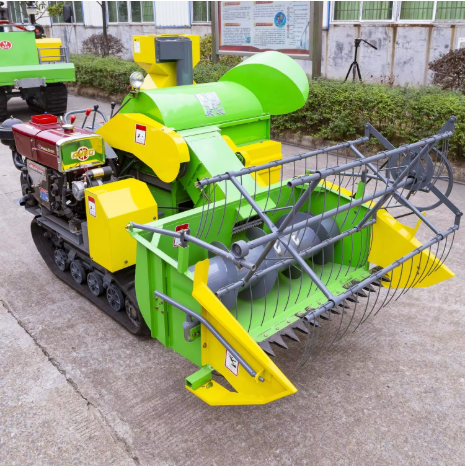Core Components of a Rice Harvester
Cutting Mechanism: Initiating the Harvest
Cutting mechanisms are really important for rice harvesting since they slice through rice plants right at ground level, making it possible to start the actual harvest work without delays. Most modern rice harvesters come with super sharp blades made specifically for this job so farmers don't lose too much grain during collection. What makes these machines even better is that many of them let operators tweak how high or low the blades cut depending on what kind of rice they're dealing with. Research shows there's actually quite a big difference when farmers get the cutting height just right, sometimes boosting total yield as much as 15 percent. The latest models going around now take things a step further with automatic cutting systems that sense changes in the field and adjust themselves while working, which means less downtime and better results across the board for most growers.
Threshing Unit: Separating Grain from Stalks
The threshing unit plays a really important role in getting those edible grains away from the stalks, which affects how long it takes to harvest and just how efficient the whole operation ends up being. Back in the day, farmers relied on simple beaters to do this job, but nowadays most equipment uses spinning drums instead. These new systems separate grains much better while keeping the actual kernels intact. Agricultural experts report that these improvements in threshing tech have pushed grain recovery rates past 98 percent in many cases. Farmers need to get their threshing settings right though because if they're off even slightly, valuable grain gets lost and what does make it through might not be as good quality either. Getting those adjustments spot on makes all the difference between a profitable harvest and one where too much gets wasted.
Separation System: Isolating Edible Grains
The separation system in rice harvesters works to get rid of all those pesky husks and straw so farmers end up with just the good stuff they want to eat. Most machines do this through some mix of blowing air around and running the material through different sized screens. When done right, this whole separation business makes for better tasting rice and keeps it fresh longer since there's less junk mixed in. Some newer models now use what's called cyclonic airflow tech. These advanced systems separate seeds much better while losing almost nothing during the process, which means farmers don't waste as much product when harvesting their crops.
Cleaning System: Removing Debris
After separation, the cleaning mechanism in rice harvesters kicks in to sweep away whatever bits of dirt and plant material remain on the grains before they get stored. Most machines rely on combinations of mesh screens and air blowing systems to flush out stuff like dust particles and bits of straw that cling to the rice. Farmers know from experience that cleaner grain fetches better prices at market. Some research suggests farmers might actually make around 5 percent extra when selling rice that's been properly cleaned of all those little bits and pieces. Recent improvements to these cleaning setups now let them run nonstop throughout harvesting season, which cuts down on machine downtime and means fewer workers needed to manually clean batches between operations.
Grain Handling: Storage and Discharge
The way rice gets handled after cutting makes all the difference for storing and getting rid of the crop properly, especially when trying to keep moisture out and stop pests from ruining things. These days most modern rice harvesters have big storage tanks built right into them, holding enough grain so farmers don't have to stop every few minutes just to dump what they've collected. Getting these grain handling methods right can cut down on losses after harvest by around 20 percent, which means real money saved for the farm operation. We're seeing some pretty cool tech developments too, like automatic discharge systems that make moving the harvested rice onto trucks much smoother and faster than before, cutting down on wasted time and effort during those busy harvest periods.
Operational Workflow of a Rice Harvester
Step 1: Cutting and Feeding Rice Plants
When operating a rice harvester, the process starts with the cutting mechanism slicing through rice plants at specific heights set beforehand. Getting this right matters because it helps keep things consistent across fields where different rice varieties grow. After cutting comes the feeding system job, which needs to keep those cut plants moving steadily into the machine. Good feeding systems really make a difference here, reducing stoppages and getting more work done overall. Some farms report seeing almost a 20% increase in productivity when their feeding systems are working properly. That kind of improvement shows just how important these early stages are in the whole harvesting operation.
Step 2: Threshing Process Explained
After cutting the rice plants and feeding them into the machine, threshing starts right away. This step breaks apart those tough stalks so we can get all the grains out properly. These days most machines come with some pretty smart engineering inside. They're built to reduce how many grains get crushed during processing while still getting most of them separated from the plant material. Farmers tell stories about how important it is to keep checking on that threshing part regularly. A little bit of oil here, tightening some bolts there makes a huge difference when trying to maintain good results across multiple seasons of harvesting.
Step 3: Grain Separation Techniques
When it comes to separating grains during processing, the system uses air blasts and screening mechanisms to get rid of unwanted material. Modern equipment allows farmers to tweak settings on the fly depending on what kind of grain they're working with and how wet or dry it is. This flexibility makes a real difference in operation speed. With better separation methods, crops reach market standards faster than before. For growers, this means higher yields per batch and less wasted product, which translates into actual money saved at harvest time.
Step 4: Final Cleaning and Storage
Cleaning comes last in the whole process, and this step gets rid of whatever dirt or contaminants are still stuck on the grains, which makes for a much better finished product overall. Once everything's clean, storing those grains right becomes really important too. If stored improperly, they'll start to rot or lose quality fast, cutting down how long they can be kept before selling. Good storage practices actually extend shelf life quite a bit, something that matters a lot to farmers who want to maximize profits from their harvest. That's why proper grain storage isn't just some afterthought at the end of harvesting operations it's basically part of what determines whether a farming season was successful or not.
Types of Rice Harvesters and Their Mechanisms
Combine Harvesters: All-in-One Efficiency
Combine harvesters have become something of a game changer in farming because they do it all in one go cutting crops, separating grain from chaff, and cleaning everything up right there on the field. Farmers love how these big machines cut down on so much work that used to require several different pieces of equipment. For bigger farms especially, having just one machine instead of three or four makes life so much easier. The time savings are pretty impressive too many farmers say they spend around 30% less time harvesting when using combines versus older methods. Beyond saving money on fuel and maintenance costs, this consolidated approach means more grain gets harvested before bad weather hits or pests start causing problems.
Traditional vs. Mechanized Threshing Methods
Traditional threshing techniques still hang on in certain rural areas, but mechanical alternatives are rapidly becoming the norm across most farms. These machines cut down on both money spent on workers and hours needed to complete the job, making them a far better choice for today's agriculture industry. The world needs to produce way more food than ever before, and these machines help get that done faster. Farming experts keep pointing out that going mechanical isn't just good business sense it's actually necessary if we want to feed everyone coming into our cities from the countryside. New tech keeps showing up all the time too, so farmers who invest now find themselves saving money month after month while their neighbors struggle to keep up with labor shortages. This shift toward automation makes the whole food system work smoother, from field to market.
Technological Advancements in Harvesting
Automated Systems for Precision Farming
Rice farming is getting smarter thanks to automation technology. These new systems use sensors throughout the field that help fine tune when and how the harvest happens. The machines actually change settings while working based on what they sense in the environment around them. Farmers find this really helpful because it means better harvests without wasting so much grain. Some studies show farms using these automated methods see about 10 to 15 percent more rice coming out at the end of season. That kind of improvement matters a lot for small scale growers trying to make ends meet. Automation isn't just fancy tech anymore it's becoming essential equipment for anyone serious about growing rice profitably today.
Adapting to Heat-Resistant Rice Varieties
Climate change keeps throwing new obstacles at farmers, so tech improvements have really stepped up to help adapt how we harvest heat resistant rice strains like IR64 and NERICA. These new methods do more than just keep yields steady they actually take pressure off traditional farming setups when weather goes all over the place. Farm conditions are getting harder to predict day by day, which means updating our tech isn't just nice to have it's basically what makes rice growing possible long term. Agricultural scientists point out that without these tech fixes, many regions would struggle to grow rice through extreme temperatures and erratic rainfall. Farms that adopt these innovations tend to bounce back faster from bad seasons and still produce decent crops even when Mother Nature throws curveballs.
FAQ
What is the purpose of the cutting mechanism in a rice harvester?
The cutting mechanism is crucial for slicing through rice plants at their base, initiating the harvest process efficiently. It ensures a uniform cut, which is essential for optimizing throughput and enhancing overall yields.
Why is the threshing unit important during rice harvesting?
The threshing unit separates edible grains from the stalks, ensuring minimal grain damage and maximizing separation rates. Proper adjustment is vital to prevent grain loss and maintain the quality of the harvest.
How does the separation system improve rice quality?
The separation system isolates edible grains from undesired materials such as husks and straw, leading to higher quality rice by reducing impurities and enhancing storage longevity.
What role does automation play in rice harvesting?
Automation in rice harvesting enhances precision by adjusting operations based on real-time data and optimizing parameters to improve yield, minimize waste, and boost overall productivity.
How do combine harvesters improve the efficiency of rice harvesting?
Combine harvesters integrate cutting, threshing, and cleaning operations into one machine, reducing operational time by up to 30% and increasing productivity, particularly beneficial for large-scale operations.

